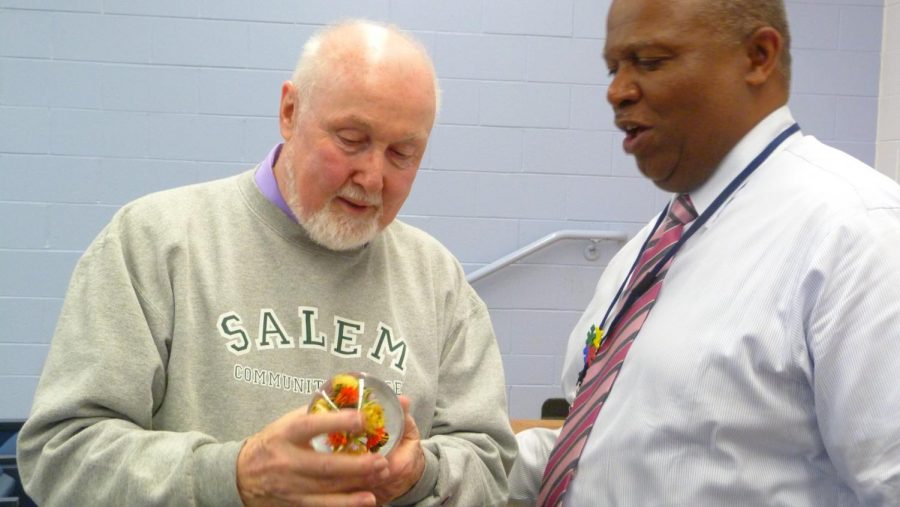Paul Stankard takes material from the past and sculpts the future
Glass artist Paul Stankard shows Mr. Tull one of his creations.
“I’m sharing my golden memory. I’m at the end of my journey and you’re at the beginning of your journey.”
This is how South Jersey glass artist Paul Stankard began his presentation to Eastern art students on Friday, April 27th in the Recital Hall. Stankard, who is originally from Massachusetts, showcased some of his intricate glass orbs and explained how he came to work in glass art over forty years ago. Over the years, he has made over 5,500 glass sculptures.
Proudly donning a Salem Community College sweatshirt, Stankard explained how after graduating from his alma mater, he worked in the scientific glass industry for nine years before switching over to glass art in 1972.
“I loved the idea of melting glass and manipulating it with my hands and making instruments,” he said.
The Millville Rose, a glass paperweight which he considered a “lost art,” was an object of his fascination in the early years of his career.
Starting with small glass animals made in his spare time, Stankard switched over to glass owers. Over time, he gradually began to introduce more visual information into his glass orbs.
Stankard said that the intricate process of sculpting the glass flowers and other bits of glass artistic media that go into his orbs and paperweights takes about 100 hours, give or take.
“It depends on the level of ambition. I’ve done large assemblages that mostly are in museums now. I’m represented in about 100 museums around the world,” he said. Some of these museums include the Metropolitan in New York and the Philadelphia Museum of Art.
Stankard cited Walt Whitman’s “Song of Myself,” Northwestern painter Morris Graves, and even contemporary work like Dave Chiluhly as having particular in uence or inspiration on his work. Emphasis was put particularly on Whitman, who “celebrates the common man” and “nurtured my artistic maturity.”
“I’m interested in presenting the glass in organic credibility. Even though my flowers can be imaginary, people believe they’re real and that’s a win. I have an attitude that my labor is my prayer. I think spirituality is a primary ingredient,” Stankard said.
Whitman’s celebrated themes of the appreciation of nature and the relationship between humans and the natural state are particularly apparent in Stankard’s Botanical Series, a series of human forms and flowers suspended in glass. Stankard began this project in order to “push experimentation and bring the same depth of feeling in my work as Whitman brings in his poems.”
With all of the complexities in his work, Stankard said that he encounters challenges all of the time when it comes to the process of creating his art.
“Every step of the way. There is a lot of risk taking in my work. Meaning I’m constantly pushing the process, pushing the limits of the material,” Stankard said. “When I focus on sculpting a flower in glass, I research it as much as possible and look at illustrations. I prefer that because it’s a human interpretation rather than a photograph, which is mechanical.”
The actual glass sculpting consists of dipping the tiniest pieces of glass repeatedly into a flame. Stankard makes all of the components with a gas oxygen flame and encapsulates them in clear glass, which he drops onto the colored glass. Then he adds glass to the bottom and heats the whole sculpture in a heating chamber.
Currently, Stankard is crafting pieces that retail from $6,000 to $10,000.
For any young artists looking into glass art, Stankard said to “familiarize yourself with the eld. Identify 4 or 5 area colleges that offer glass. I’m a product of Salem Community College. And you can go online and survey contemporary glass.”
To see more of Stankard’s work locally, visit Wheaton Arts in Millville, New Jersey, where a retrospective collection of 75 pieces will be on display until December 31st.


